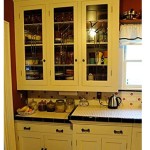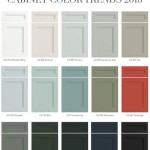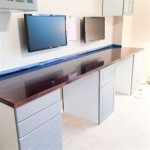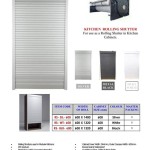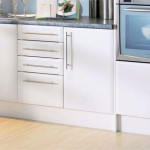What Are The Items Found In A Kitchen?
A kitchen is a fundamental part of any dwelling, serving as a central location for preparing and consuming food. Consequently, it houses a diverse collection of items, categorized by their function and purpose. Understanding the variety of these items offers insight into the operations and the range of culinary possibilities within a typical kitchen.
Cooking Utensils
Cooking utensils comprise the tools directly involved in the cooking process. These items facilitate the preparation and manipulation of food during heating and other transformative procedures. The specific utensils included in a kitchen often reflect the owner's cooking habits and preferred cuisines, but certain items are considered essential.
Spatulas are employed for flipping, stirring, and scraping food from cooking surfaces. These can be constructed from various materials, including metal, silicone, and wood, each possessing unique properties and optimal uses. Metal spatulas are sturdy and effective for high-heat cooking, while silicone spatulas are heat-resistant and gentle on non-stick coatings. Wooden spatulas are valued for their non-reactivity and rustic appeal.
Mixing spoons, typically made of wood, plastic, or metal, are employed for combining ingredients. Their design allows for thorough mixing without damaging delicate components. Different sizes and shapes are available to suit various mixing tasks, from gently folding in air to vigorously blending thick batters.
Whisks are designed for incorporating air into mixtures, creating light and airy textures. They are essential for whipping cream, beating eggs, and emulsifying sauces. Whisks come in different shapes and sizes, including balloon whisks for maximum aeration and flat whisks for working in shallow pans.
Tongs are used for gripping and lifting food items, particularly during grilling, frying, and serving. Their long handles provide safety and precision. Metal tongs are widely used for their durability and heat resistance, while silicone-tipped tongs offer a gentler grip and prevent scratching.
Ladle represent another essential utensil, used for portioning and serving liquids, such as soups, stews, and sauces. Ladles are typically made of stainless steel or heat-resistant plastic and come in various sizes to accommodate different serving needs.
Beyond these basics, other commonly found cooking utensils include slotted spoons for straining liquids, basters for moistening meat during roasting, and graters for shredding cheese and vegetables. The selection of cooking utensils present in a kitchen directly influences the range of achievable culinary tasks.
Cookware
Cookware refers to the pots, pans, and related items used for cooking food on a stovetop, in an oven, or over an open flame. The quality and type of cookware significantly affect cooking performance and outcomes. Similar to cooking utensils, the range of cookware available depends on the user's needs and preferences.
Saucepans are fundamental pots with long handles and straight sides, suitable for heating liquids, cooking grains, and making sauces. They are often made from stainless steel, aluminum, or copper, each offering different heat conductivity and responsiveness. Stainless steel saucepans are durable and easy to clean, while copper saucepans provide rapid and even heating.
Frying pans, also known as skillets, are shallow pans with sloping sides, ideal for searing, sautéing, and frying. They are available in various materials, including cast iron, stainless steel, and non-stick coatings. Cast iron frying pans retain heat exceptionally well and can be used for a wide range of cooking techniques. Non-stick frying pans prevent food from sticking and are easy to clean, but require careful maintenance to avoid scratching the coating.
Stockpots are large, deep pots used for making stocks, soups, and stews. They are typically made of stainless steel or aluminum and have a tight-fitting lid to retain heat and moisture. Stockpots are essential for preparing large batches of liquid-based dishes.
Dutch ovens are heavy-bottomed pots with tight-fitting lids, traditionally made of cast iron. They are versatile cookware items suitable for braising, roasting, and baking. Dutch ovens provide even heat distribution and excellent heat retention, making them ideal for slow cooking and one-pot meals.
Baking dishes are generally made of glass, ceramic, or metal, and come in a variety of shapes and sizes. They are used for baking casseroles, gratins, and other oven-baked dishes. Glass baking dishes allow for easy monitoring of the baking process, while ceramic baking dishes provide even heat distribution.
Other common cookware items include roasting pans, baking sheets, and specialty pans for muffins, cakes, and pies. The specific cookware selection reflects the types of dishes frequently prepared in the kitchen.
Appliances
Kitchen appliances are electrical devices designed to automate and simplify food preparation tasks. These range from large, permanent fixtures to smaller, portable units. Appliances contribute significantly to the efficiency and convenience of modern kitchens.
Refrigerators are essential appliances used for storing perishable food items at low temperatures, preventing spoilage and extending shelf life. Refrigerators come in various sizes and configurations, including top-freezer, bottom-freezer, and side-by-side models. Modern refrigerators often include features such as adjustable shelves, temperature controls, and water and ice dispensers.
Ovens are used for baking, roasting, and broiling food. They can be either freestanding or built-in and are typically powered by electricity or gas. Ovens provide precise temperature control and even heat distribution, ensuring consistent cooking results. Convection ovens use a fan to circulate hot air, resulting in faster and more even cooking.
Cooktops, also known as stovetops, provide a surface for cooking food in pots and pans. They can be electric, gas, or induction-based. Electric cooktops use heating elements to transfer heat to the cookware, while gas cooktops use flames. Induction cooktops use electromagnetic fields to directly heat the cookware, offering efficient and precise temperature control.
Microwave ovens use microwave radiation to quickly heat food. They are convenient for reheating leftovers, cooking frozen meals, and performing other quick cooking tasks. Microwave ovens are typically compact and easy to operate.
Dishwashers are used for washing dishes automatically, saving time and effort. They use hot water and detergent to clean dishes, then rinse and dry them. Dishwashers come in various sizes and configurations, including built-in and portable models.
Smaller, countertop appliances include blenders, toasters, coffee makers, and food processors. Blenders are used for mixing liquids and pureeing ingredients, while toasters are used for browning bread and pastries. Coffee makers brew coffee, and food processors chop, slice, and shred food. These smaller appliances enhance the versatility and functionality of the kitchen.
Other commonly found appliances include stand mixers for baking, slow cookers for preparing meals over extended periods, and electric kettles for boiling water quickly. The selection of appliances present in a kitchen depends on the individual's cooking needs and preferences.
Food Storage Containers
Food storage containers are essential for preserving leftovers, organizing ingredients, and packing lunches. These containers vary in material, size, and design, each offering unique benefits for different storage needs. Proper use of food storage containers can significantly reduce food waste and maintain the quality of stored items.
Plastic containers are lightweight, durable, and relatively inexpensive. They are available in various shapes and sizes, with airtight lids to prevent leaks and maintain freshness. However, some plastics can leach chemicals into food, particularly when heated. For this reason, it is advisable to use BPA-free plastic containers.
Glass containers are non-reactive, meaning they do not leach chemicals into food. They are also microwave-safe and oven-safe, making them versatile for reheating and cooking. Glass containers are generally more expensive than plastic containers, but they offer superior durability and safety.
Stainless steel containers are durable, non-reactive, and resistant to stains and odors. They are an excellent option for storing food in the refrigerator or freezer, but they are not microwave-safe. Stainless steel containers are a sustainable and long-lasting choice for food storage.
Silicone containers are flexible, heat-resistant, and easy to clean. They are often used for storing snacks, packing lunches, and freezing food. Silicone containers are a lightweight and space-saving option for food storage.
In addition to the material, the design of food storage containers is important. Airtight containers help prevent food from drying out or absorbing odors from the refrigerator. Stackable containers save space and keep the refrigerator organized. Clear containers allow for easy identification of the contents.
Other food storage items include reusable bags, wraps, and lids. Reusable bags are a sustainable alternative to plastic sandwich bags. Wraps, such as beeswax wraps, are used to cover food and keep it fresh. Lids can be used to cover bowls and other containers that do not have their own lids.
Proper food storage practices are essential for maintaining food safety and quality. Food should be stored at appropriate temperatures, in airtight containers, and for the recommended amount of time. Regular cleaning of food storage containers is also important to prevent the growth of bacteria.
Cutlery and Dinnerware
Cutlery and dinnerware are the items used for serving and consuming food. They contribute to the overall dining experience and are selected based on functionality, aesthetics, and personal preferences. The range of cutlery and dinnerware can vary from simple everyday sets to elaborate collections for special occasions.
Forks are used for piercing and lifting food. They typically have two to four tines and are made of stainless steel, silver, or other materials. Dinner forks are the standard size, while salad forks are smaller and used for salads and appetizers.
Knives are used for cutting food. They have a sharp blade and can be serrated or non-serrated. Dinner knives are used for cutting meat and other main course items, while butter knives are used for spreading butter and other soft spreads.
Spoons are used for scooping and consuming liquids and semi-solid foods. They come in various sizes and shapes, including tablespoons, teaspoons, soup spoons, and dessert spoons. Spoons are typically made of stainless steel, silver, or other materials.
Plates are used for serving food. They come in various sizes and shapes, including dinner plates, salad plates, and dessert plates. Plates can be made of ceramic, glass, porcelain, or other materials. Dinner plates are the standard size for main courses, while salad plates are smaller and used for salads and appetizers.
Bowls are used for serving soups, salads, and other foods that contain liquids. They come in various sizes and shapes, including soup bowls, salad bowls, and cereal bowls. Bowls can be made of ceramic, glass, porcelain, or other materials.
Glasses are used for serving beverages. They come in various sizes and shapes, including water glasses, wine glasses, and juice glasses. Glasses can be made of glass, crystal, or other materials. Wine glasses are specifically designed to enhance the aroma and flavor of wine.
Other cutlery and dinnerware items include serving utensils, such as serving spoons, serving forks, and ladles. Placemats and tablecloths are used to protect the table and enhance the dining experience. Napkins are used for wiping hands and mouths during the meal.
The selection of cutlery and dinnerware depends on individual preferences and the type of meals typically served. Matching sets of cutlery and dinnerware create a cohesive look, while mixing and matching different styles can add personality to the table setting.

Things In The Kitchen Learn With Examples For Kids

List Of Kitchen Items Javatpoint

Learning Kitchen Items Flashcards In English

Over The Years I Have Definitely Found My Must Kitchen Items That Use And Th Haves First Apartment

List Of 70 Kitchen Utensils Names With Pictures Tool Cooking Set

English Voary 100 Kitchen Items

50 Kitchen Utensils Items And Appliances Name

Kitchen Essentials The Basics Cooking Jar

Kitchen Utensils List Of Essential Tools With Pictures 7esl

Mastering Kitchen Voary A Comprehensive List Of Utensils In English

